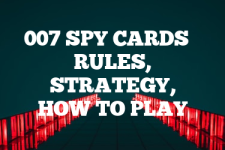QuickStrike: Strategy Guide with Rules & Instructions
Introduction
QuickStrike is a collectible card game that’s been around since 2006. It’s all about strategy, quick thinking, and a bit of luck. The game has a history reaching into other games, with many players joining the ranks over the years. Several subsequent TCGs and CCGs used the QuickStrike system (including games I’ve written guides about previously, like Avatar TCG and Pirates of the Caribbean TCG). It’s a game where you can collect different cards, each with its own powers and abilities, and use them to battle against opponents. The aim is to outsmart the other player and win the match by reducing their life points to zero.

Unfortunately, for those looking to get into the game, the original QuickStrike cards are no longer in print. This means that finding cards can be a bit of a treasure hunt, but it also adds to the charm and the challenge of the game. Collectors and players often trade or buy cards from each other, keeping the community alive and the game exciting. But lots of card gamers around the globe have adapted the QuickStrike system for use in other card games, so understanding how it works can be pretty interesting if you want a new twist in some of your favorite CCGs and TCGs.
Quick Tip for QuickStrike
Always keep an eye on your opponent’s discard pile – it can give you valuable insights into their strategy!
Rules for playing QuickStrike
Understanding the rules of QuickStrike is key to enjoying the game. Each player starts with a deck of cards and a set number of life points. The game progresses in turns, with each player drawing cards, playing cards, and attacking with the goal of reducing the opponent’s life points. There are specific rules about how many cards you can play, how attacks work, and what special abilities can do. It’s important to know these rules inside out to play effectively.
Card Types for QuickStrike
QuickStrike has several types of cards, each serving a different purpose in the game – they break down as Chamber cards (Strike, Advantage, Ally). You’ve got your character cards, which are the main cards you’ll use to attack your opponent. Then there are action cards that can change the game’s flow, and special cards with unique abilities that can turn the tide of a match. Understanding what each card does is crucial for building a strong deck.
How to Play QuickStrike and Game Mechanics
In this game, two characters face off in one-on-one battles, each player controlling one character. The main aim? To be the first to reach three points. You get a point when your opponent fails to defend against an attack that breaks through all three of their colored zones.
Playing QuickStrike involves a few key mechanics. You need to set up your deck, draw cards, and manage your hand to make the most of your turn. Gameplay involves playing cards, attacking, and using abilities at the right time. The game ends when one player’s life points hit zero, so keeping track of your life points and your opponent’s is a big part of the strategy.
In games using the QuickStrike system, there’s a twist compared to many card games: no playing cards from your hand. Instead, players flip cards from the top of their decks at specific moments. The cards you flip fall into three types:
- Strikes: Blue-bordered cards for offense or defense, either to launch attacks or block opponents’ moves.
- Advantages: Gold-bordered cards holding special tactics and training, offering various uses, like charging a zone.
- Allies: Purple-bordered cards symbolizing allies lending a helping hand.
Each player holds a Chamber card, concealing powerful character signature moves. At key points in the game, these moves can be slid out from the Chamber, unveiling their might.
In these games, a playmat sets the stage with three colored zones for each player: green, yellow, and red. They act as defensive lines and storage spots for energy and allies.
When under attack, defending starts in their green zone, flipping a card to defend. If it’s a strike with enough defense and the energy cost is covered, a counterattack kicks in. Advantages or allies revealed can also join in, given the cost is paid. Unable to cover the cost? No worries, store the card facedown as energy. If an attack slips through, it moves to the next zone. Another card flip, another chance to act. But if it hits the red zone, oops, point to the opponent! Time for them to celebrate.
When a player’s all charged up across all their zones, they’ve got a shot at unleashing a signature move (as long as they’ve got the energy). To make it happen, they uncharge the zones and reveal the hidden signature strike from their Chamber card.
These signature move cards pack a punch with two moves—one on each side. The Chamber card starts with the weaker front-facing move. After a signature move is played, it gets flipped over before being tucked back into the Chamber, ready for the opposite move next time it’s unleashed.
For a deck to be legit in QuickStrike, it needs a minimum of 60 cards, maxing out at four copies of each card.
Picking a Chamber card is a must, and it dictates what goes in your deck. Each Chamber card has symbols that guide which cards match. No symbols? Goes in any deck.
Here’s the scoop on the symbols:
Strike Types:
- Bull: Hardcore offense, high risk, high power.
- Fox: Tricky, strategic, about outsmarting opponents.
- Lion: Defense-focused, building up without getting torn down.
Advantage Types:
- Body: Straightforward boosts/hindrances, physical focus.
- Mind: Strategic, peek at decks, plan ahead.
- Spirit: Energy manipulation, luck/foresight plays.
Ally Types:
- Light: Good and just characters.
- Shadow: Ambiguous alignment or freedom-loving.
- Dark: Evil and corrupt characters.
Set-Specific Strikes:
- Avatar: The Last Airbender Icons: Fire, Water, Earth, Air.
- Pirates of the Caribbean Icons: Sail, Sword, Cannon.
Starter decks usually pack only 30 cards per player, not fully legal decks by the game’s standards.
How to Win at QuickStrike
Winning at QuickStrike isn’t just about having the best cards; it’s about how you use them. Beginners should focus on understanding the basic strategies, like when to attack and when to hold back. Intermediate players can start to look for combos and more complex plays. Advanced players will need to think several moves ahead, anticipate their opponent’s strategy, and adapt quickly to changing situations.
Best Strategies for playing QuickStrike
The best strategies in QuickStrike come down to a combination of deck building, knowledge of the game, and the ability to read your opponent. You want to build a deck that has a good balance of attack and defense, and that can handle a variety of situations. Knowing the game means understanding the rules and the cards so well that you can make the most of every turn. Reading your opponent means paying attention to their plays and trying to figure out what they’re holding back.
Deck Building and Best Cards in QuickStrike
Building a strong deck is a big part of QuickStrike. You want a deck that reflects your play style and can handle different challenges. Some cards are considered better than others because of their power and versatility. Because you don’t specifically hold a hand of cards and choose from that hand in a QuickStrike game, it’s really important to have a balance of Strike, Advantage and Ally cards.
Scenarios
In QuickStrike, you’ll face both good and bad scenarios. A good scenario might be having a strong hand with lots of options. A bad scenario could be when you’re low on life points and your opponent has a full field of characters. The key is to stay calm and think strategically about how to use your cards to change the situation to your advantage.
Frequently Asked Questions about playing QuickStrike game
When playing QuickStrike, you might have some questions. Here are some common ones:
Q: How many cards can I play in one turn? A: It depends on the cards and the situation, but usually, you can play one character card and any number of action cards.
Q: Can I attack on my first turn? A: No, you cannot attack on the first turn of the game.
Q: What happens if I run out of cards? A: If you can’t draw a card because your deck is empty, you lose the game.
Additional Tips for QuickStrike
Aside from the main aspects of the game, there are a few more things to keep in mind:
- Practice makes perfect. The more you play, the better you’ll get.
- Watch others play. You can learn a lot by observing different strategies.
- Stay updated. Even though the game isn’t in print, the community might have house rules or updates that can affect how you play.
External Links
The QuickStrike can be adapted to other card games with varying success. Here’s a list of card games by the originator, Upper Deck Entertainment

A digital native around since the early days of online gaming communities around 2001. An early contributor to the cult gaming site ClanTemplates, Adam has spent years giving free gaming resources to the community. With BoardCards, Adam is most experienced and commonly writing the articles on Strategy multi-player games like Settlers of Catan and Avalon. His first introduction to board games was via Mancala, an Egyptian-origin stone game and one of the oldest known games still played worldwide. Contact me via email



